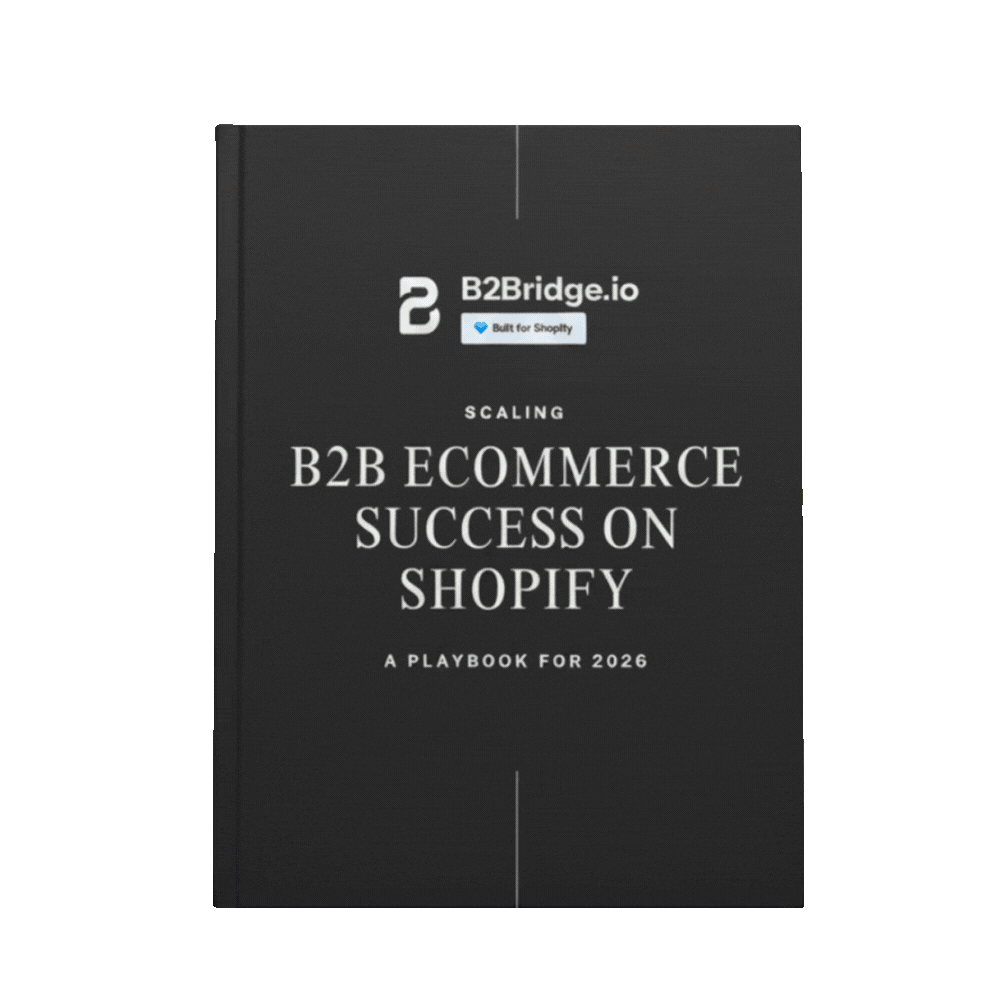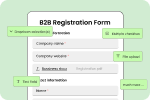The B2B Ecommerce landscape is experiencing unprecedented transformation. By 2026, the global B2B Ecommerce market is projected to surpass $2 trillion, with digital channels now accounting for over 60% of all B2B transactions. For businesses seeking growth, understanding and adapting to emerging B2B Ecommerce trends 2026 isn’t just an advantage – it’s essential for survival.
This comprehensive guide explores the 18 most critical B2B marketing trends, B2B content marketing trends, and Ecommerce future trends you need to implement now to stay competitive and position yourself at the forefront of the future of B2B Ecommerce.
B2B Ecommerce Statistics: Key Facts Driving B2B Ecommerce Evolution
Understanding these key facts is essential, as they reveal the fundamental shifts shaping the future of B2B Ecommerce – setting the stage for the 18 critical trends that every business must consider to thrive in the evolving digital marketplace.
- 73% of B2B buyers now expect to research and compare options online before engaging with sales teams, making digital presence non-negotiable
- 78% of B2B decision-makers say their purchase experience is as important as product quality, driving demand for seamless omnichannel experiences
- Mobile devices account for 57% of B2B browsing activity, yet only 30% of B2B sites are fully mobile-optimized – a massive gap creating urgency for mobile-first strategies
- 61% of B2B buyers expect personalized experiences tailored to their specific industry and use case, explaining the rise of AI personalization
- B2B buyers are 4x more likely to require flexible payment terms than they were five years ago, with 68% preferring Net 30 or longer payment windows
- Companies leveraging AI-driven operations report 2.5x faster order processing and 35% improvement in customer satisfaction
- Omnichannel B2B businesses achieve 2x higher retention rates and 30% higher average order values compared to single-channel competitors
- B2B platforms like Shopify have grown 40% year-over-year, forcing traditional suppliers to expand beyond direct channels
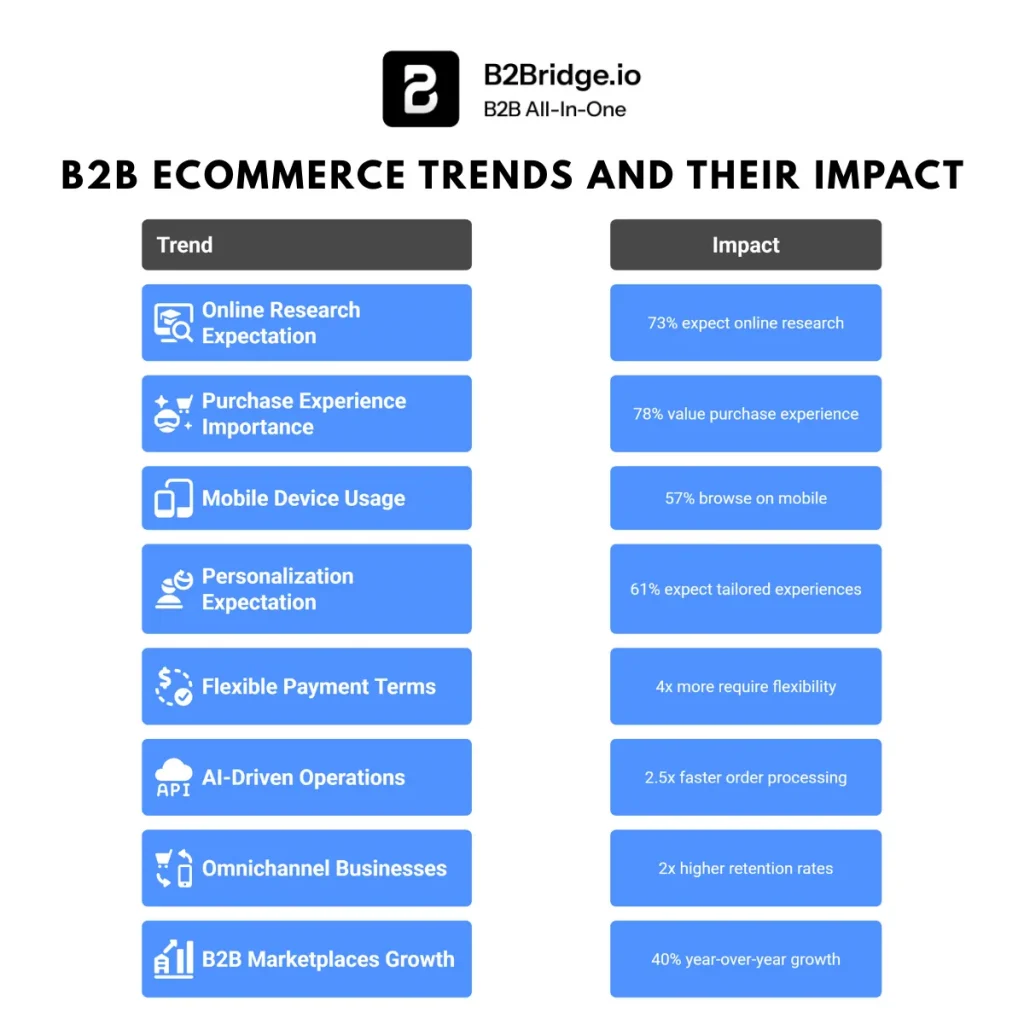
These facts reveal why the 18 trends below aren’t optional – they’re survival requirements in a rapidly evolving B2B landscape.
Whether you’re a manufacturer, distributor, or wholesale business, the trends shaping B2B ecommerce in 2026 directly impact your bottom line. From AI-driven personalization to flexible payment terms, these shifts fundamentally change how buyers interact with suppliers and how companies structure their sales operations.
18 B2B Ecommerce Trends to Grow your Business
1. Personalization and Customer-Centric Experiences
2. Advanced Wholesale Pricing Strategies
3. Net Payment Terms and Flexible Financing
4. Omnichannel and Seamless Integration
5. Composable Commerce and MACH Architecture
6. Self-Service Buyer Portals
7. Streamlined Onboarding and Automated Registration
8. Competitor Benchmarking and Market Intelligence
9. Ecosystem Partnerships and Future-Proofing
10. AI-Driven Operational Efficiency
11. Enhanced Product Information Management (PIM)
12. Logistics, Fulfillment, and Supply Chain Resilience
13. Data Governance, Privacy, and Compliance
14. Mobile-First and Dedicated B2B Apps
15. Marketplace Expansion and Cross-Channel Selling
16. Social Media’s Role in B2B Engagement
17. Dynamic and Personalized Pricing Approaches
18. Sustainability and Ethical Practices
1. Personalization and Customer-Centric Experiences
Modern B2B buyers expect personalized experiences similar to what they experience in B2C. AI-driven personalization has moved from a nice-to-have to a competitive necessity in current Ecommerce trends and represents one of the most significant B2B marketing trends reshaping how companies engage with wholesale buyers.
Why It Matters: Personalized experiences increase customer loyalty by up to 80% and drive 40% higher engagement rates. In B2B contexts, this means tailoring product recommendations, pricing displays, and content based on individual buyer behavior, company profile, and purchase history.
Implementation Tips:
- Use AI algorithms to analyze buyer behavior and recommend relevant products
- Segment customers by industry, company size, and buying patterns
- Create dynamic landing pages that reflect each buyer’s role and needs
- Personalize email campaigns with product suggestions based on past purchases
When you implement genuine personalization, you’re not just increasing conversion rates – you’re building lasting buyer relationships that extend across multiple transactions and departments within client organizations.
>> Explore: B2B vs B2C Ecommerce: Key Differences and Trends
2. Advanced Wholesale Pricing Strategies
One of the most critical B2B Ecommerce trends is the shift toward dynamic, tiered pricing models that account for volume, customer segment, and market conditions.
Modern Pricing Approaches:
- Tiered Pricing: Offer graduated discounts based on order quantity
- Dynamic Pricing: Adjust prices in real-time based on demand, inventory, and competitor activity
- Account-Based Pricing: Customize rates for high-value customers or strategic accounts
- Geographic Pricing: Reflect regional market conditions and competition
Protecting Pricing Integrity: A common challenge in wholesale businesses is preventing retail customers from seeing wholesale pricing, which can undermine your brand positioning and channel relationships. Advanced solutions now allow you to display different prices to different customer segments automatically – showing retail pricing to consumers while wholesale pricing appears only for verified B2B accounts.
>> Read more: How To Calculate Your Wholesale Pricing: Formulas & Tips To Set Up
For example, a furniture manufacturer using segmented pricing can display retail pricing on its public site while showing tiered wholesale discounts exclusively to registered dealers and distributors. This approach protects margin integrity while offering incentives for bulk orders.
Real-World Impact: Companies implementing dynamic wholesale pricing strategies report 15-25% increases in average order value and improved inventory turnover. The key is ensuring the right price reaches the right buyer at the right time.
B2Bridge enables you to build a private B2B portal directly inside your existing Shopify store. This app empowers businesses to create flexible pricing logic, customer-specific catalogs, enabling dynamic tiered pricing, customer-specific discounts, and volume-based incentives – all designed to optimize profitability and encourage larger orders.
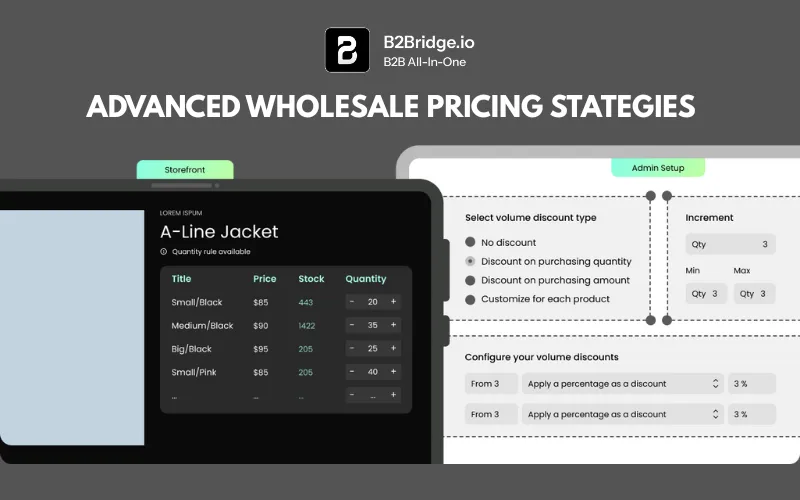

3. Net Payment Terms and Flexible Financing
Flexible payment terms have become a key differentiator in B2B Ecommerce. Offering Net 30, Net 60, or Net 90 terms is now standard practice – and it’s a powerful tool for buyer acquisition and retention.
Understanding Payment Terms:
- Net 30: Invoice due within 30 days of purchase
- Net 60: Invoice due within 60 days of purchase
- Net 90: Invoice due within 90 days of purchase
Why This Matters for Buyers: Extended payment terms directly improve cash flow management, allowing businesses to receive goods, resell them, and collect payment from their own customers before paying their suppliers. For many B2B buyers, access to favorable net terms is as important as product quality or pricing.
Benefits for Sellers:
- Attract higher-value customers who require extended terms
- Increase order frequency and average transaction size
- Reduce buyer friction during checkout
- Build stronger, longer-term customer relationships
Businesses that offer flexible payment terms see 35% higher customer lifetime value and significantly improved deal closure rates. The challenge lies in managing credit risk and cash flow implications – automated solutions that verify buyer creditworthiness and manage payment collection timelines are essential for scaling this capability.
With B2Bridge, offering flexible net payment terms (net 30/60/90) and tailored financing options becomes seamless, giving buyers the payment flexibility they need while helping businesses improve cash flow and reduce payment friction.
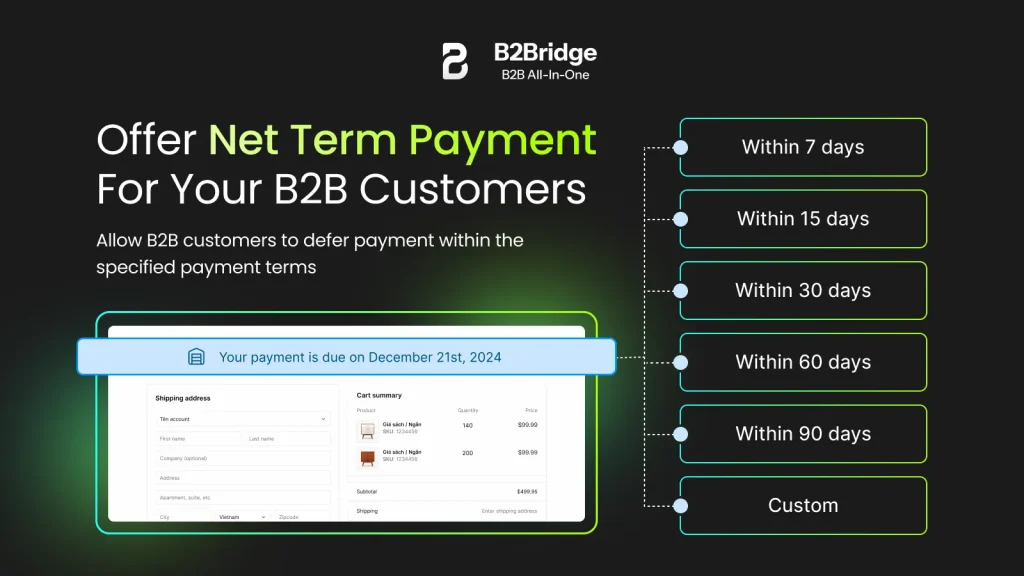
4. Omnichannel and Seamless Integration
B2B buyers today interact with suppliers across multiple channels: your website, mobile apps, marketplaces like Shopify, and even social platforms. Omnichannel integration is no longer optional in the future of B2B Ecommerce.
Key Channels to Integrate:
- Direct website and mobile applications
- Third-party marketplaces (Shopify, Amazon Business, Global Sources)
- Social commerce platforms (LinkedIn, YouTube)
- Traditional sales channels and inside sales teams
Benefits of Seamless Integration: Consistent buyer journeys increase purchase completion rates by up to 50%. When customers can start browsing on mobile, compare options on your website, and complete purchases on a marketplace – all with the same pricing and product information – you dramatically reduce friction and expand market reach.
Tools that enable real-time inventory synchronization, unified order management systems (OMS), and centralized customer data platforms are essential for successful omnichannel B2B Ecommerce.
5. Composable Commerce and MACH Architecture
The rise of composable commerce and MACH (Microservices, API-first, Cloud-native, Headless) architecture represents a fundamental shift in how B2B Ecommerce platforms are built.
Why MACH Matters: Traditional monolithic platforms lock you into rigid systems. MACH architecture uses microservices – independent, specialized components that communicate via APIs. This approach enables:
- Scalability: Add or upgrade specific functions without rebuilding your entire system
- Customization: Tailor the platform to your unique B2B processes
- Flexibility: Integrate best-of-breed solutions for different business functions
- Speed: Deploy changes and new features faster than traditional platforms
For complex B2B operations with unique requirements – like integrated ERP systems, multi-currency pricing, or advanced wholesale workflows – MACH architecture provides the flexibility to build exactly what you need rather than compromising with off-the-shelf limitations.
6. Self-Service Buyer Portals
Empowering buyers with self-service portals improves satisfaction and reduces support burden. Modern B2B buyer portals include:
Essential Portal Features:
- Order Tracking: Real-time visibility into order status and delivery
- Invoice Management: Access and download historical invoices
- Reorder Functionality: Quick access to previous purchase history for repeat orders
- Account Management: Update billing addresses, payment methods, and user permissions
- Reporting Tools: Generate custom reports on spending, usage, and trends
- Document Management: Access technical specs, certifications, and compliance documents
Self-service portals reduce support costs by 30-50% while improving buyer satisfaction scores. When buyers can find answers and complete tasks independently, satisfaction increases despite reduced direct interaction.
B2Bridge enhances buyer autonomy by providing intuitive self-service portals that enable customers to place orders, track shipments, and access personalized pricing anytime – improving satisfaction and operational efficiency.

7. Streamlined Onboarding and Automated Registration
First impressions matter. The registration and onboarding process significantly impacts buyer experience and conversion rates in B2B Ecommerce.
Friction Points in Traditional Onboarding:
- Manual verification processes requiring days to complete
- Complex forms requiring extensive manual data entry
- Delayed approval preventing immediate purchase capability
- Repeated verification for different roles or departments
Modern Streamlined Approach: Automated registration leveraging identity verification services, business database lookups, and credit scoring can reduce onboarding from days to minutes. Buyers can complete registration, receive immediate approval, and begin purchasing without manual intervention.
B2Bridge Solution: Solutions like B2Bridge automate the entire registration and onboarding workflow, including identity verification, credit evaluation, and account provisioning. This not only improves buyer experience but also reduces fraud risk and administrative overhead.
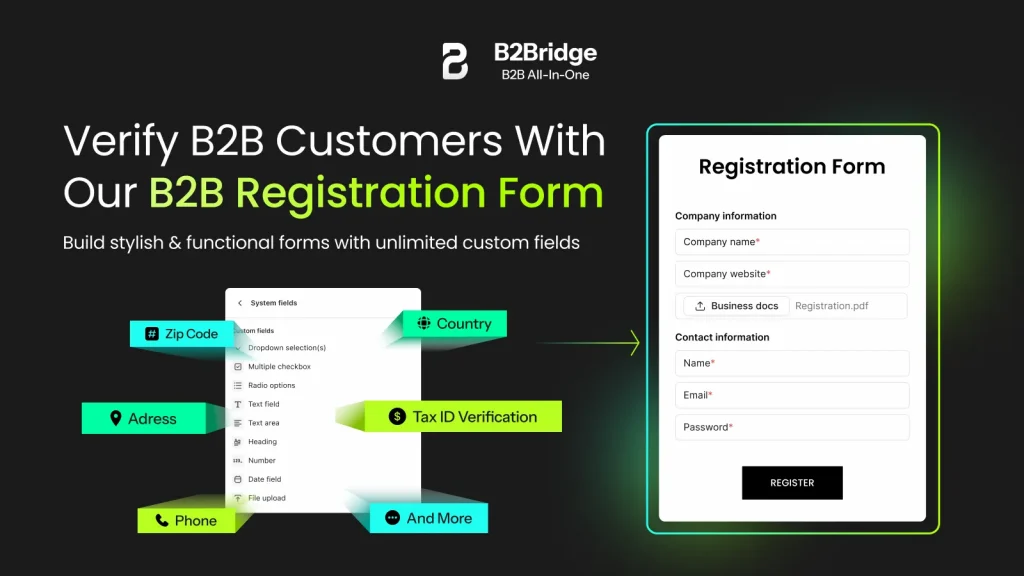
8. Competitor Benchmarking and Market Intelligence
Understanding where you stand relative to competitors helps guide strategic investments and identify gaps in your B2B Ecommerce capabilities.
Key Metrics to Monitor:
- Website Performance: Site speed, mobile optimization, SEO rankings
- Feature Comparison: Functionality and capabilities available to buyers
- Pricing Transparency: How competitors display pricing and terms
- Customer Reviews: Satisfaction scores and feedback on competitor platforms
- Content Strategy: Topics, formats, and frequency of competitor content
- Social Media Presence: Engagement levels and content performance
Regular competitive analysis, combined with buyer feedback, provides the context needed to prioritize platform investments and feature development.
9. Ecosystem Partnerships and Future-Proofing
No single platform can address every B2B Ecommerce need. Success increasingly depends on building integrated ecosystems of best-of-breed solutions working seamlessly together.
Key Partnership Areas:
- ERP Integration: Synchronized inventory, pricing, and order data
- Payment Processing: Multiple payment methods including credit cards, ACH, and emerging options
- Logistics Integration: Real-time carrier rate shopping and shipment tracking
- CRM Systems: Unified customer view across sales, support, and marketing
- Analytics Platforms: Comprehensive insights into buyer behavior and performance
- Tax and Compliance: Automated tax calculation and regulatory compliance
By selecting platforms with open APIs and strong ecosystem support like Shopify, you ensure your technology stack can evolve as business needs change and new technologies emerge.
Had a Shopify store? Use B2Bridge’s Public API feature, designed to streamline B2B Ecommerce operations. By providing secure and flexible access to key data like customer groups and price lists, these APIs empower merchants to automate workflows, integrate with existing systems, and deliver personalized pricing experiences.
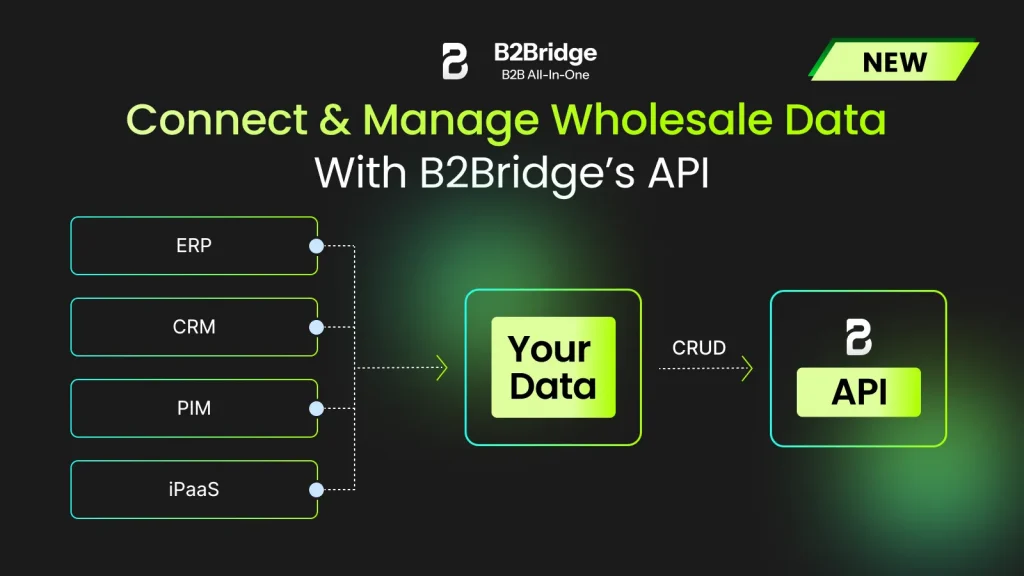
10. AI-Driven Operational Efficiency
Artificial intelligence is transforming B2B Ecommerce operations beyond just personalization. Modern AI applications include:
Key AI Applications:
- Demand Forecasting: Predict customer needs and optimize inventory planning
- Fraud Detection: Identify suspicious transactions and protect revenue
- Automated Quote Management: Generate accurate quotes instantly based on customer specifications
- Chatbot Support: Provide instant answers to common buyer questions 24/7
- Predictive Analytics: Anticipate churn risk and identify upsell opportunities
- Dynamic Inventory Management: Allocate stock intelligently across channels
Business Impact: Companies leveraging AI for operations report 30-40% improvements in operational efficiency, 25% reduction in support costs, and 20% improvement in forecast accuracy. The ROI justifies the investment, particularly for mid-market and enterprise B2B operations.
11. Enhanced Product Information Management (PIM)
Accurate, comprehensive product information across all channels is fundamental to B2B Ecommerce success. Product Information Management (PIM) systems centralize and manage product data at scale.
Why PIM Is Critical: B2B buyers need detailed specifications, compliance information, technical documentation, and compatibility details. Inconsistent or incomplete product information across your website, apps, and marketplace listings creates buyer confusion and reduces conversion rates.
Modern PIM Features:
- AI-powered product search that understands technical specifications
- Automated categorization and attribute assignment
- Multi-language and multi-currency support
- Integrated digital asset management for technical drawings and datasheets
- AI chatbot assistance helping buyers find the right products faster
When combined with AI, PIM systems can dramatically improve the buyer experience by helping customers find exactly what they need despite the complexity of large product catalogs.
12. Logistics, Fulfillment, and Supply Chain Resilience
B2B buyers increasingly expect faster, more transparent delivery. Supply chain visibility and operational resilience have become competitive differentiators in current Ecommerce trends.
Essential Capabilities:
- Order Management Systems (OMS): Centralize orders from all channels and automate fulfillment routing
- 3PL Partnerships: Leverage third-party logistics providers to scale without capital investment
- Real-Time Tracking: Provide buyers with accurate, up-to-the-minute delivery information
- Inventory Visibility: Show accurate stock levels across locations in real-time
- Shipping Rate Automation: Calculate accurate quotes and automatically route to optimal carriers
Market Expectations: B2B buyers now expect 2-3 day delivery on standard orders, with some industries demanding same-day or next-day options. Developing supply chain resilience – through diversified sourcing, regional distribution centers, and technology investments – is essential for meeting these expectations.
13. Data Governance, Privacy, and Compliance
As B2B data volumes increase, governance, privacy, and compliance requirements become more complex. Regulations like GDPR and CCPA impose strict requirements on how you collect, store, and use customer data.
Critical Compliance Areas:
- Data Privacy: Clear policies on data collection and usage
- Security Standards: Implementation of encryption, access controls, and security monitoring
- Audit Trails: Maintain comprehensive logs of data access and modifications
- Consent Management: Document explicit buyer consent for data usage
- Incident Response: Establish protocols for addressing data breaches quickly
Building Trust: Transparent data practices and robust security measures aren’t just compliance obligations – they build buyer trust and become a competitive advantage. In B2B relationships, where transactions involve significant value and long-term commitments, trust is paramount.
14. Voice and Conversational Commerce
AI tools like ChatGPT are transforming more than just customer support – they’re reshaping how purchasing decisions are made. Younger buyers, including Gen Z and millennials now leading B2B procurement, increasingly turn to AI assistants for product research and decision-making. Reports show that 57% of Gen Z and 48% of millennials consult AI tools when shopping online.
This shift is part of the broader rise of conversational commerce, where chat- and voice-based interactions drive discovery and sales. Global spending through these channels is projected to surpass $32.67 billion by 2035, fueled by real-time support and seamless omnichannel experiences.
B2B commerce mirrors this trend. What once happened through in-person discussions at trade shows or meetings is now happening digitally – streamlined through chat interfaces, AI-powered recommendations, and online portals that remove the need for a traditional sales rep.
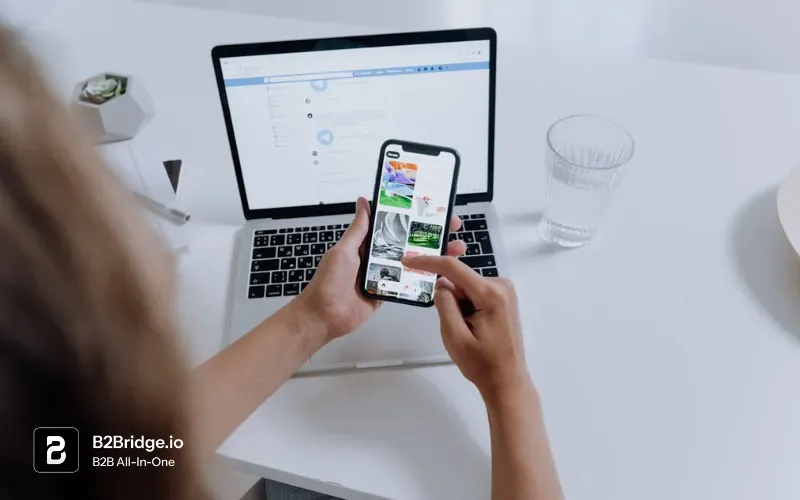
15. Marketplace Expansion and Cross-Channel Selling
Shopify, Alibaba, and industry-specific marketplaces represent significant sales channels for B2B companies. However, managing inventory, listings, and pricing across multiple marketplaces introduces operational complexity.
Marketplace Management Challenges:
- Inventory Synchronization: Prevent overselling across channels
- Listing Consistency: Maintain accurate product information across all platforms
- Pricing Alignment: Manage different pricing strategies while protecting margins
- Order Consolidation: Fulfill orders from multiple channels efficiently
- Performance Tracking: Monitor sales and profitability by marketplace
Strategic Approach: Rather than viewing marketplaces as separate channels, treat them as extensions of your broader B2B Ecommerce strategy. Centralized management tools that synchronize inventory, pricing, and order fulfillment across all channels dramatically reduce operational friction and improve profitability.
16. Social Media’s Role in B2B Engagement
Social commerce has emerged as a powerful channel in B2B marketing trends. Platforms like LinkedIn, YouTube, and industry-specific forums drive awareness, build trust, and influence purchasing decisions. Understanding social commerce trends is critical to success in today’s digitally-connected B2B landscape.
Most Effective B2B Social Channels:
- LinkedIn: Thought leadership, industry insights, and professional networking
- YouTube: Product demonstrations, technical tutorials, and customer success stories
- Industry Forums: Community engagement and peer recommendations
- Twitter/X: Real-time industry news and company updates
Content Types That Resonate:
- Case studies showing quantified business results
- Product demonstrations addressing specific use cases
- Thought leadership on industry trends
- Customer testimonials and success stories
- Educational content that addresses buyer pain points
Social media in B2B primarily drives awareness and builds trust rather than direct sales. However, this awareness significantly influences buying decisions when prospects are ready to evaluate options. Companies with strong B2B social presence typically see 2-3x higher engagement from social-sourced leads compared to cold outreach.
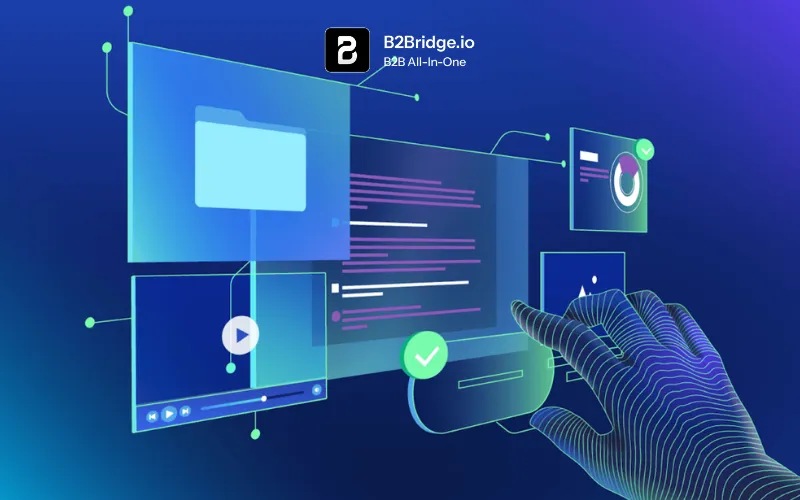
17. Dynamic and Personalized Pricing Approaches
Beyond basic tiered pricing, sophisticated dynamic pricing adjusts prices in real-time based on multiple factors including buyer behavior, inventory levels, demand patterns, and competitive positioning.
Advanced Pricing Strategies:
- Behavioral Pricing: Show different prices based on browsing history and engagement
- Inventory-Based Pricing: Increase prices for low-stock items, discount overstock
- Time-Based Pricing: Offer limited-time promotions tied to specific events or seasons
- Competitive Pricing: Automatically adjust prices based on competitor offerings
- Customer-Specific Pricing: Implement loyalty discounts or volume-based incentives
Implementation Considerations: While dynamic pricing increases revenue, it requires careful management to maintain buyer trust and ensure fairness. Transparent communication about how prices are calculated, combined with clear volume discount structures, helps buyers understand pricing rationale.
18. Sustainability and Ethical Practices
Environmental and social responsibility have become increasingly important to B2B buyers. Sustainability initiatives aren’t just marketing – they’re business imperatives that influence purchasing decisions and build competitive advantage.
Areas of Focus:
- Supply Chain Transparency: Document environmental impact across your supply chain
- Sustainable Packaging: Use recyclable or compostable materials
- Carbon Reduction: Implement initiatives to reduce operational emissions
- Ethical Sourcing: Partner with suppliers meeting fair labor and environmental standards
- Product Lifecycle: Design products for durability and recyclability
Organizations implementing comprehensive sustainability programs report increased buyer loyalty, access to new customer segments, and improved employee retention. In some industries, sustainability credentials are now table-stakes for winning deals.
Roadmap for Successful B2B Ecommerce Trend Integration
To successfully capitalize on the evolving B2B ecommerce landscape in 2026, companies need a clear, phased implementation roadmap that aligns with both immediate needs and long-term strategic goals.
Quick Wins (0-3 Months)
Begin by leveraging existing customer data to identify personalization opportunities and enhance automated campaigns tailored to the buyer’s journey stage. Incorporate social proof such as testimonials and case studies into your self-service portal to build trust and encourage buyer engagement. These initial steps provide immediate impact with minimal disruption.
Medium-Term Initiatives (3-9 Months)
Invest in AI-driven predictive analytics to unify data and forecast buyer demands more accurately, improving inventory and marketing efficiency. Launch subscription models for recurring products or services to increase customer retention and predictable revenue streams. Additionally, explore listings on popular B2B marketplaces like Shopify, Amazon Business and Alibaba to extend your reach where buyers prefer to shop, optimizing product listings and integrating with your ecommerce platform for seamless operation.
Long-Term Strategy (9-18 Months and Beyond)
Focus on integrating an omnichannel approach that unifies customer experiences across digital and offline touchpoints. Advance further with AI and machine learning applications to deeply personalize buying experiences and automate routine operations for speed and accuracy. Ensure continuous data-driven refinement of your ecommerce strategy, tracking key metrics such as conversion rates, average order value, and customer lifetime value to scale successful initiatives while pivoting away from underperforming tactics.
This roadmap ensures your business is agile, customer-centric, and technologically equipped to navigate the complex and fast-moving B2B commerce environment projected for 2026 and beyond. Following these stages will help you not only keep pace with evolving buyer expectations but also position your brand as a leader in the digital B2B marketplace.
Ready to Capitalize on these B2B Ecommerce Trends?
Run your B2B channel as easily as B2C with tools designed specifically for wholesale operations. B2Bridge’s all-in-one wholesale platform includes price segmentation, net payment terms, mobile-first design, and automated onboarding – helping you implement these 2026 trends without complexity. Scale confidently without spreadsheets or manual workarounds. Give your B2B buyers the smooth, self-serve shopping journey that builds loyalty and closes deals.
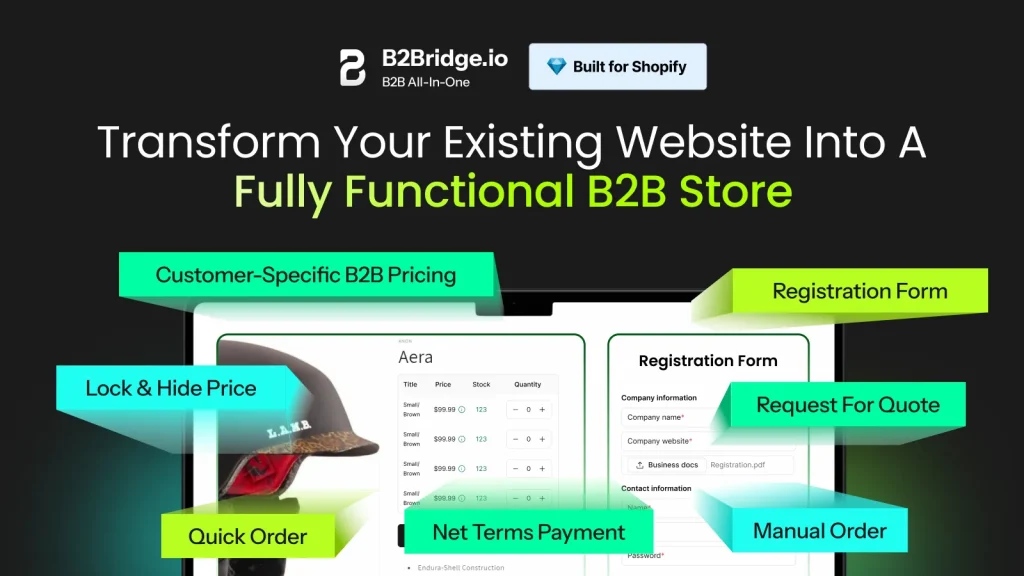
Start your future-proof B2B Ecommerce transformation today.
Case Study: From Spreadsheets to Streamlined Wholesale Operations
The Challenge: A mid-market industrial supplier managed wholesale and retail operations using spreadsheets and multiple disconnected systems. Sales teams manually processed quotes, pricing was inconsistent across channels, and onboarding new wholesale accounts took weeks. This manual approach was incompatible with the future of B2B Ecommerce and current Ecommerce trends that demand automation and scalability.
The Solution: The company implemented an integrated B2B Ecommerce platform leveraging best-in-class technology to align with Ecommerce future trends. The platform featured automated pricing management, streamlined registration, and mobile-first design. Payment terms automation was a key component, allowing the company to offer Net 30, Net 60, and Net 90 options instantly. Additionally, they invested in B2B content marketing trends, creating detailed product guides and technical resources to support buyer research and decision-making.
Results:
- Wholesale account onboarding reduced from 2-3 weeks to 24 hours
- Average order value increased 18% due to consistent tiered pricing
- Mobile orders grew to 35% of total volume within 6 months
- Support costs decreased 40% as buyers used self-service portals
- Wholesale customer lifetime value increased 42%
- B2B content marketing efforts contributed to a 25% increase in qualified leads
See more B2Bridge’s customer stories that succeed when using our app on their Shopify store

FAQs About B2B Ecommerce Trends
Extended payment terms like Net 30, Net 60, or Net 90 significantly improve cash flow for buyers, making them more likely to consolidate purchases with suppliers offering favorable terms. Companies offering flexible terms see 35% higher customer lifetime value.
The future centers on AI personalization, omnichannel integration, flexible payment terms, and composable commerce architectures. Mobile-first experiences, data security, and sustainability will define success. Companies investing in automation and buyer-centric technology will capture market share and build lasting competitive advantages in evolving B2B landscapes.
Key 2025 trends include advanced AI-driven operations, dynamic pricing models, social commerce expansion, enhanced supply chain visibility, and flexible net payment terms. Businesses prioritize seamless omnichannel experiences, real-time inventory management, and streamlined onboarding processes to meet increasingly demanding buyer expectations and remain competitive.
The B2B Ecommerce market is projected to exceed $2 trillion by 2026, with digital channels accounting for over 60% of transactions. Growth accelerates through mobile adoption, marketplace expansion, and technology investments. Companies embracing automation, personalization, and flexible buyer terms will capture disproportionate market share.
Current B2B marketing trends emphasize AI-powered personalization, content marketing for buyer education, social commerce engagement, and account-based marketing strategies. Omnichannel approaches, transparent communication, and data-driven decision-making drive success. Building trust through thought leadership and streamlined buyer experiences remains critical.
Businesses deploying AI for forecasting, fraud detection, and automation report 30-40% improvements in operational efficiency, 25% cost reductions in support, and 20% improvements in forecast accuracy.
Consistent buyer journeys across channels increase purchase completion rates by up to 50%, while expanding reach to new customer segments through marketplace and social channels.
Conclusion
The B2B Ecommerce trends shaping 2026 represent a fundamental shift toward buyer-centric, technology-enabled operations. From AI-driven personalization to flexible payment terms, these trends directly impact your ability to attract buyers, build loyalty, and scale profitably.
The most successful B2B Ecommerce businesses don’t chase every trend – they identify the handful most relevant to their market and customers, then invest in best-of-breed solutions to implement them effectively. Whether you’re focusing on omnichannel integration, advanced pricing strategies, or mobile-first experiences, the common thread is technology that removes friction and empowers buyers.
Hi, I’m Ha My Phan – an ever-curious digital marketer crafting growth strategies for Shopify apps since 2018. I blend language, logic, and user insight to make things convert. Strategy is my second nature. Learning is my habit. And building things that actually work for people? That’s my favorite kind of win.
